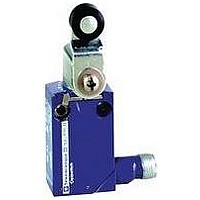XCMD2115L1 SQUARE D, XCMD2115L1 Datasheet - Page 198

XCMD2115L1
Manufacturer Part Number
XCMD2115L1
Description
LIMIT SWITCH, 1NO.1NC, 240VAC, 250VDC, 6A
Manufacturer
SQUARE D
Datasheet
1.XCKD2102N12.pdf
(246 pages)
Specifications of XCMD2115L1
Actuator Style
Roller Lever
Operating Force Max
0.1N
Switch Operation
(ON)
Contact Voltage Ac Max
240V
Contact Voltage Dc Max
250V
Contact Current Ac Max
6A
Contact Current Dc Max
6A
Lead Free Status / RoHS Status
Contains lead / RoHS non-compliant
- Current page: 198 of 246
- Download datasheet (20Mb)
Limit Switches
9007C Heavy Duty Industrial—Non-Plug-in Body, Metal
Hazardous Location
Hazardous Non-Plug-in Body Type (1)
1.
b Application Information—Hazardous Locations
Classification of hazardous locations
Hazardous locations are those areas that may have flammable gases or combustible dusts present in quantities sufficient to produce an
explosive or ignitable mixture. These gases, dusts, may always be present or may only be present in abnormal situations. The National Electrical
Code (NEC) describes these areas in Articles 500 through 503 and divides them into three types of categories: Class, Group, Division.
•
•
•
The table below summarizes the classifications described above.
198
Summary of Classification Chart
Class
I. Gas
II. Dust
III. Fibers
Factory modifications: see pages 176 to 180.
Classes
The Classes (I, II, III) differentiate between the type of hazardous materials: I is for gases,II is for dusts, and III is for fibers.
Groups
The Groups (A, B, C, D, E, F, and G) further subdivide each class according to the relative explosive force of the materials. Group A
atmosphere is acetylene which has a higher explosive force than Group B (which may contain hydrogen, for example); and Group B has a
higher explosive force than Group D, etc.
Divisions
The Divisions (1 and 2) refer to the presence of these hazardous gases and dusts. Division 1 areas can have these gases or dusts present at
all times under normal operating conditions in an ignitable concentration. Division 2 areas only have ignitable concentrations of dusts
or gases present during abnormal conditions, such as machine failures or container breakage.
© 1997–2007 Schneider Electric All Rights Reserved
Division
1. Hazard May Exist
May Exist In Atmosphere Under Normal Operating Conditions
2. Potential Hazard
A. May be present in atmosphere only
under abnormal circumstances.
1. Hazard May Exist
May Exist In Atmosphere Under Normal Operating Conditions
2. Potential Hazard
A. May be present in atmosphere only under abnormal circumstances.
1. Production Areas
2. Handling and Storage Areas
With head for linear movement
side plunger
Page 200
With head for rotary movement (lever)
Page 202
Group
A. Acetylene
B. Manufactured Gases Containing Hydrogen
C. Petrochemicals (e.g. ethylene)
D. Petrochemicals (e.g. alcohol)
A. Acetylene
B. Manufactured Gases Containing Hydrogen
C. Petrochemicals (e.g. ethylene)
D. Petrochemicals (e.g. alcohol)
E. Conductive and Combustible Dust (Resistivity y10
F. Carbonaceous Dusts (Resistivity >10
G. Non-Conductive Combustible Dust (Resistivity > = 105 ohms/cm)
G. Non-Conductive Combustible Dust (Resistivity > = 105 ohms/cm)
Easily Ignitable Fibers
Easily Ignitable Fibers
top plunger
Page 201
With head for multi-directional movement
Page 203
2
ohm/cm but < 108ohm/cm)
5
ohms/cm)
03/2007
Related parts for XCMD2115L1
Image
Part Number
Description
Manufacturer
Datasheet
Request
R

Part Number:
Description:
Pushbutton, Non-Illum'd Red "STOP", Momentary, 1NO-1NC, Square 30mm, 10A, 600V
Manufacturer:
SQUARE D
Datasheet:

Part Number:
Description:
KITS,TWIDO? PROGRAMMABLE CONTROLLERS,KITS,TWIDOPACK STARTER KIT - ADVANCED LEVEL,PROGRAMMABLE CONTROLLERS,TWIDO? PROGRAMMABLE CONTROLLERS ,SQUARE D
Manufacturer:
SQUARE D

Part Number:
Description:
LAMPS,INDICATOR,STACKABLE,LAMPS, STACKABLE INDICATOR,VISUAL INDICATING SIGNALS,XVB SERIES INDICATING BANKS ,SQUARE D
Manufacturer:
SQUARE D

Part Number:
Description:
LAMPS,INDICATOR,STACKABLE,LAMPS, STACKABLE INDICATOR,VISUAL INDICATING SIGNALS,XVB SERIES INDICATING BANKS ,SQUARE D
Manufacturer:
SQUARE D
Datasheet:

Part Number:
Description:
I/O EXTENDER MODULE 4 D IN & 2 D OUTPUT
Manufacturer:
SQUARE D
Datasheet:

Part Number:
Description:
CB ACCESSORY, UNDERVOLTAGE TRIP 48V DC
Manufacturer:
SQUARE D
Datasheet:











